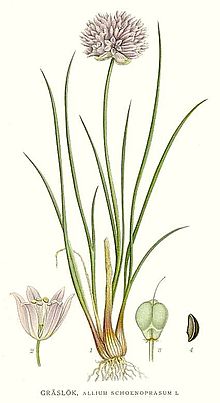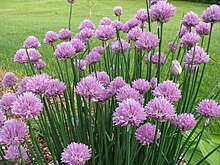Allium schoenoprasum
| Chives Allium schoenoprasum |
|
|---|---|
 |
|
 |
|
| Allium schoenoprasum | |
| Scientific classification | |
| Kingdom: | Plantae |
| Clade: | Angiosperms |
| Clade: | Monocots |
| Order: | Asparagales |
| Family: | Amaryllidaceae |
| Subfamily: | Allioideae |
| Genus: | Allium |
| Species: | A. schoenoprasum |
| Binomial name | |
|
Allium schoenoprasum L. |
|
| Synonyms | |
|
Synonymy
|
|

A clump of flowering chives
|
|
| Nutritional value per 100 g (3.5 oz) | |
|---|---|
| Energy | 126 kJ (30 kcal) |
|
4.35 g
|
|
| Sugars | 1.85 g |
| Dietary fiber | 2.5 g |
|
0.73 g
|
|
|
3.27 g
|
|
| Vitamins | |
| Vitamin A equiv. |
(27%)
218 μg
(24%)
2612 μg323 μg
|
| Thiamine (B1) |
(7%)
0.078 mg |
| Riboflavin (B2) |
(10%)
0.115 mg |
| Niacin (B3) |
(4%)
0.647 mg |
| Pantothenic acid (B5) |
(6%)
0.324 mg |
| Vitamin B6 |
(11%)
0.138 mg |
| Folate (B9) |
(26%)
105 μg |
| Vitamin C |
(70%)
58.1 mg |
| Vitamin E |
(1%)
0.21 mg |
| Vitamin K |
(203%)
212.7 μg |
| Minerals | |
| Calcium |
(9%)
92 mg |
| Iron |
(12%)
1.6 mg |
| Magnesium |
(12%)
42 mg |
| Manganese |
(18%)
0.373 mg |
| Phosphorus |
(8%)
58 mg |
| Potassium |
(6%)
296 mg |
| Zinc |
(6%)
0.56 mg |
|
|
|
|
|
| Percentages are roughly approximated using US recommendations for adults. Source: USDA Nutrient Database |
|
Chives is the common name of Allium schoenoprasum, an edible species of the Allium genus.
A perennial plant, it is widespread in nature across much of Europe, Asia, and North America.
A. schoenoprasum is the only species of Allium native to both the New and the Old Worlds.
The name of the species derives from the Greek σχοίνος, skhoínos (sedge) and πράσον, práson (leek). Its English name, chives, derives from the French word cive, from cepa, the Latin word for onion.
Chives are a commonly used herb and can be found in grocery stores or grown in home gardens. In culinary use, the scapes and the unopened, immature flower buds are diced and used as an ingredient for fish, potatoes, soups, and other dishes. Chives have insect-repelling properties that can be used in gardens to control pests.
Chives are a bulb-forming herbaceous perennial plant, growing to 30–50 cm (12–20 in) tall. The bulbs are slender, conical, 2–3 cm (3⁄4–1 1⁄4 in) long and 1 cm (1⁄2 in) broad, and grow in dense clusters from the roots. The scapes (or stems) are hollow and tubular, up to 50 cm (20 in) long and 2–3 mm (1⁄16–1⁄8 in) across, with a soft texture, although, prior to the emergence of a flower, they may appear stiffer than usual. The leaves, which are shorter than the scapes, are also hollow and tubular, or terete, (round in cross-section) which distinguishes it at a glance from garlic chives (Allium tuberosum). The flowers are pale purple, and star-shaped with six petals, 1–2 cm (1⁄2–3⁄4 in) wide, and produced in a dense inflorescence of 10-30 together; before opening, the inflorescence is surrounded by a papery bract. The seeds are produced in a small, three-valved capsule, maturing in summer. The herb flowers from April to May in the southern parts of its habitat zones and in June in the northern parts.
...
Wikipedia
